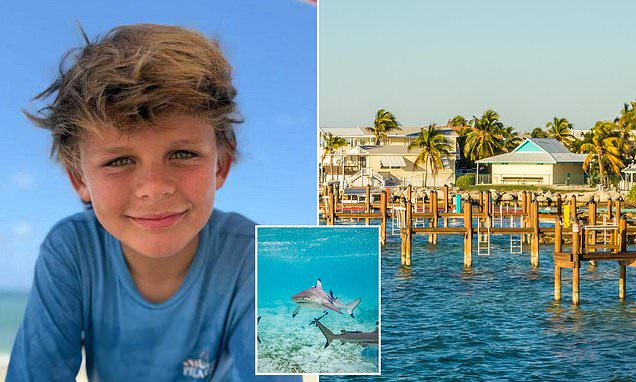In a remarkable display of courage and quick thinking, a 10-year-old girl named Rose Burrows heroically rescued her eight-year-old brother, Richard Burrows, from a shark attack while snorkeling off the Florida coast on Labor Day, September 1, 2025. The incident, which occurred near John Pennekamp Coral Reef State Park in Key Largo, Florida, has captured global attention, highlighting the bravery of a young girl and the resilience of her injured brother. This article provides a comprehensive account of the incident, the circumstances surrounding it, the medical and emotional aftermath, and the broader context of shark attacks in Florida, drawing on multiple sources to offer a detailed and nuanced narrative.
The Incident: A Terrifying Encounter in Key Largo
On a sunny Labor Day afternoon, the Burrows family—Richard, his 10-year-old sister Rose, and their father David, aged 48—were snorkeling in the pristine waters of Horseshoe Reef, approximately four miles off the coast of Key Largo near John Pennekamp Coral Reef State Park. The family was enjoying a recreational outing in one of Florida’s most renowned snorkeling destinations, known for its vibrant coral reefs and diverse marine life. However, what began as a joyful family activity quickly turned into a life-threatening ordeal.
At around 3:30 p.m., a blacktip reef shark attacked eight-year-old Richard, biting him on the knee and causing a severe injury. Blacktip reef sharks, common in Florida’s coastal waters, are typically non-aggressive but can attack if provoked or attracted by factors such as blood or bait in the water. According to the Florida Museum of Natural History, the presence of seared fish blood, often associated with spearfishing, can attract sharks, though the Burrows family was snorkeling, not spearfishing, at the time of the attack. Spearfishing is illegal in Monroe County, which includes the boundaries of John Pennekamp Coral Reef State Park, and the family’s statement confirmed they were engaged in snorkeling when the shark struck.
Richard’s cries for help pierced the air as the shark’s bite caused significant blood loss. In a moment of extraordinary bravery, his sister Rose sprang into action. Alongside their father, David, Rose helped hold up Richard’s leg to stem the bleeding, a critical first aid measure that likely prevented further complications. A 911 call obtained by the Miami Herald revealed the urgency of the situation, with Rose’s composure under pressure standing out as a defining factor in her brother’s survival. Nearby snorkelers and a dive boat in the vicinity also played a crucial role, assisting in getting Richard to shore and ensuring he received immediate medical attention.
Richard was rushed to a local hospital, where surgeons operated on his knee on the night of the attack. The procedure was successful, and Sheriff Rick Ramsay confirmed to the Miami Herald that doctors managed to save Richard’s leg, averting the need for amputation. The family later issued a statement expressing gratitude for the swift response of bystanders and medical professionals, noting that “the initial injury inflicted on Richard was significant, but due to the help of a number of people, it was contained.” They praised Rose’s “strength of character and composure” under pressure, describing her as “instrumental” in her brother’s rescue.
The Aftermath: Recovery and Resilience
Richard’s recovery has been described as miraculous by both his family and medical professionals. Following the surgery, he was reported to be in good spirits, gaining strength daily. The family’s statement expressed optimism about his future, stating, “Our hope is that he will be back enjoying his passion for the ocean and marine life with his older sister in no time.” This sentiment reflects Richard’s love for marine activities, a passion he shares with Rose, and underscores the family’s determination to move forward from the traumatic incident.
Rose, meanwhile, has emerged as a hero in the eyes of her family and the public. Her parents, David and his wife, expressed immense pride in her actions, noting that her quick thinking and bravery were pivotal in saving her brother’s life. The incident has also highlighted the strength of the sibling bond between Rose and Richard, with their shared experience in the water forging an even deeper connection. The family’s gratitude extended to the dive boat crew, fellow snorkelers, and medical teams who contributed to Richard’s survival, emphasizing the collective effort that made his recovery possible.
The emotional toll of the incident cannot be understated. For a 10-year-old to witness her younger brother being attacked by a shark and to respond with such poise is extraordinary. Child psychologists note that traumatic events like this can have lasting effects on young children, potentially leading to anxiety or fear of the water. However, the Burrows family’s focus on Richard’s recovery and their public expressions of hope suggest a commitment to supporting both children through the aftermath. Community support, including messages of encouragement from local residents and online well-wishers, has also played a role in uplifting the family during this challenging time.
The Context: Shark Attacks in Florida
The shark attack on Richard Burrows is part of a broader pattern of shark-human interactions in Florida, which is often referred to as the “shark bite capital of the world.” According to the International Shark Attack File (ISAF), maintained by the Florida Museum of Natural History, Florida recorded 14 unprovoked shark bites in 2024, accounting for half of all such incidents in the United States and nearly a third of global cases. The state’s warm waters, abundant marine life, and high number of beachgoers and water sports enthusiasts create conditions conducive to shark encounters.
Blacktip reef sharks, like the one that attacked Richard, are among the most common species involved in such incidents. These sharks typically grow to about 5-6 feet in length and are known for their agility and speed. While they are not considered a serious threat to humans, they can bite if they mistake a person for prey or are attracted by factors such as blood or splashing. The ISAF notes that unprovoked shark attacks are rare, with only 47 confirmed cases worldwide in 2024, four of which were fatal. The odds of being attacked by a shark remain extremely low—approximately 1 in 11.5 million for beachgoers in the United States.
The Burrows family’s incident underscores the unpredictable nature of marine environments. John Pennekamp Coral Reef State Park, a popular destination for snorkeling and diving, is home to a diverse array of marine species, including sharks. While the park’s regulations prohibit spearfishing to minimize shark attraction, incidents like this highlight the need for continued education and awareness about water safety. The Florida Museum advises beachgoers to avoid swimming alone, stay close to shore, and refrain from wearing shiny jewelry or splashing excessively, as these can attract sharks.
Comparative Cases: Other Recent Shark Attacks in Florida
The Burrows family’s experience is not an isolated incident. Florida’s waters have seen several shark attacks in 2025, reflecting the state’s unique position as a hotspot for such encounters. In June 2025, a 9-year-old girl named Leah Lendel was attacked by a shark while snorkeling off Boca Grande, Florida, suffering severe injuries to her hand. Leah’s mother, Nadia, described the harrowing moment when she saw her daughter’s hand “hanging on by just the skin,” with blood everywhere. Leah was airlifted to Tampa General Hospital, where surgeons performed a six-hour operation to reattach her hand, using arteries from her leg to restore blood flow. Leah’s recovery, like Richard’s, has been described as a “miracle,” with the young girl able to move her fingers just days after surgery.
Another incident occurred in August 2025, when an 8-year-old girl, Harper Ochoa, was bitten by a shark while swimming in shallow waters in Galveston, Texas, though the injury occurred close to the Florida border. Harper sustained a gruesome wound to her calf, requiring 13 staples to close. Her mother initially mistook the attack for a stingray incident, highlighting the confusion that often accompanies such events.
These cases underscore the unpredictability of shark attacks and the importance of quick response and medical intervention. They also highlight the resilience of young victims and the critical role of family members and bystanders in ensuring survival. Rose Burrows’ actions mirror those of other heroes in similar incidents, such as Rhett Willingham, a firefighter who rescued his 17-year-old sister, Addison Bethea, from a shark attack off Keaton Beach, Florida, in 2022. Rhett applied a tourniquet to Addison’s leg, saving her life, though she ultimately lost her leg to amputation.
The Role of Community and Emergency Response
The successful outcome of Richard’s case owes much to the coordinated response of the community and emergency services. The dive boat crew and nearby snorkelers acted swiftly to assist the Burrows family, helping to transport Richard to shore and stabilize his condition. The 911 call, as reported by the Miami Herald, captured the urgency and teamwork involved, with Rose and David working together to control the bleeding. Emergency medical technicians and hospital staff in Key Largo were instrumental in ensuring Richard received timely care, with surgeons performing a complex procedure to repair his knee.
This collective effort reflects the strength of community response in crisis situations. In remote areas like Key Largo, where access to immediate medical care can be challenging, the role of bystanders and local responders is critical. The Burrows family’s gratitude for these efforts highlights the importance of preparedness and collaboration in coastal communities, where water-based activities are a way of life.
Broader Implications: Safety and Awareness in Marine Environments
The shark attack on Richard Burrows has reignited discussions about safety in marine environments, particularly in popular tourist destinations like Key Largo. John Pennekamp Coral Reef State Park attracts thousands of visitors annually, drawn by its crystal-clear waters and vibrant marine ecosystems. However, incidents like this serve as a reminder of the inherent risks of interacting with wildlife.
Experts emphasize the importance of education and vigilance to minimize shark encounters. The Florida Museum of Natural History recommends swimming in groups, avoiding areas with known shark activity, and refraining from activities that may attract sharks, such as fishing or discarding food in the water. While shark attacks are statistically rare, they can have profound physical and emotional impacts, particularly on young victims like Richard.
For families, the incident underscores the need for preparedness when engaging in water-based activities. Parents are encouraged to teach children basic safety protocols, such as staying close to adults and knowing how to respond in emergencies. Rose’s quick thinking serves as an inspiring example of how even young children can make a difference in crisis situations, provided they are equipped with the right knowledge and instincts.
The Emotional and Cultural Impact
The story of Rose and Richard Burrows has resonated widely, capturing the imagination of people across the globe. Social media platforms, including X, have been abuzz with messages of admiration for Rose’s bravery and support for Richard’s recovery. The narrative of a young girl saving her brother from a shark attack evokes universal themes of family, courage, and resilience, transcending cultural and geographic boundaries.
In Florida, where shark attacks are a known risk, the incident has sparked conversations about the balance between enjoying the state’s natural beauty and respecting its wildlife. Local media outlets, such as the Miami Herald and Daily Mail, have highlighted the Burrows family’s story as a testament to human courage and the power of quick thinking in life-or-death situations.
The incident also raises questions about how children process and recover from traumatic events. Mental health professionals note that while Rose’s actions were heroic, she may need support to cope with the emotional aftermath of witnessing her brother’s attack. Similarly, Richard’s recovery will likely involve not only physical rehabilitation but also psychological care to address any fears or anxieties about returning to the water.
Conclusion
The shark attack on Richard Burrows and his rescue by his sister Rose is a story of bravery, resilience, and the unbreakable bond between siblings. Rose’s quick thinking and composure under pressure saved her brother’s life, earning her widespread praise as a hero. Richard’s ongoing recovery, supported by his family and medical professionals, is a testament to the power of community and modern medicine. The incident, while traumatic, highlights the importance of preparedness, education, and vigilance in marine environments, particularly in a state like Florida, where shark encounters are a known risk.
As the Burrows family looks to the future, their story serves as an inspiration to others, demonstrating that even in the face of danger, courage and love can prevail. Rose and Richard’s shared passion for the ocean, undeterred by this harrowing experience, reflects their resilience and determination to move forward. For the global audience following their journey, the Burrows siblings are a reminder of the extraordinary acts of heroism that can emerge from the most unexpected moments.






